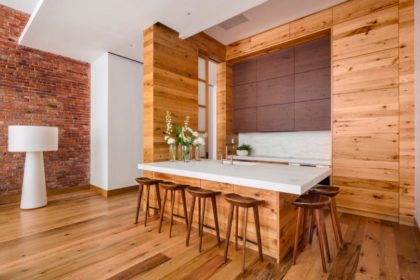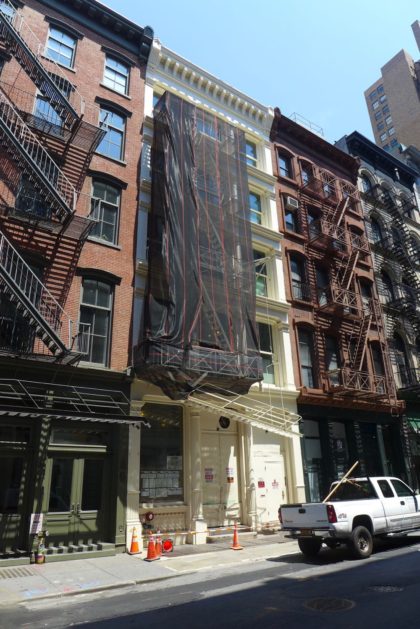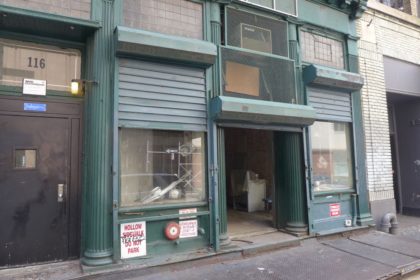Seen & Heard: 60 White Interior
••• Sorgente Group, developers of 60 White, tweeted a first peek at the interior.
 ••• 42 Walker is looking spiffy. Is it fair to assume that so many renovated buildings are painted cream because that sells for a higher price?
••• 42 Walker is looking spiffy. Is it fair to assume that so many renovated buildings are painted cream because that sells for a higher price?
 ••• Press release: “The Friends of the Lower West Side and the Washington Street Historical Society are sponsoring a block party on Washington Street between Rector and Carlisle Street on Saturday, July 30, from 1 to 5 p.m. There will be Arabic and Chinese calligraphy demonstrations for all ages, free architecture tours, talks about the former Syrian colony in the area, samples of food and beverage from local restaurants, and music performances.”
••• Press release: “The Friends of the Lower West Side and the Washington Street Historical Society are sponsoring a block party on Washington Street between Rector and Carlisle Street on Saturday, July 30, from 1 to 5 p.m. There will be Arabic and Chinese calligraphy demonstrations for all ages, free architecture tours, talks about the former Syrian colony in the area, samples of food and beverage from local restaurants, and music performances.”
••• I don’t know that I’ve ever seen action at the 116 Duane storefront….
 ••• The River Project’s 30th-anniversary benefit is this upcoming Monday, Aug. 1. From the release: “During cocktails from 6 to 7 pm, the program, aboard the Hornblower Hybrid at Pier 40, will feature a narrated ‘live dive’ that opens a window into the world of the Hudson River beneath the surface—with an underwater audio-visual connection between guests and divers in the River. The dive team includes international underwater cinematographer Dan Crowell; Chris Anderson, River Project biologist and diver; Joe Volpe, broadcast television engineer; Carl Saeva, of Sartek Industries, in charge of underwater communications; and Captain Carter Craft aboard the accompanying boat, Reel Busy. The dinner cruise through the Harbor to the Statue of Liberty, from 7 until 9 pm includes a performance by special guest Laurie Anderson. At Pier 26, renowned aquarium architect Peter Sollogub will discuss the ways in which the creatures of the Hudson River can enliven the new Estuarium being planned for Hudson River Park.” Tickets.
••• The River Project’s 30th-anniversary benefit is this upcoming Monday, Aug. 1. From the release: “During cocktails from 6 to 7 pm, the program, aboard the Hornblower Hybrid at Pier 40, will feature a narrated ‘live dive’ that opens a window into the world of the Hudson River beneath the surface—with an underwater audio-visual connection between guests and divers in the River. The dive team includes international underwater cinematographer Dan Crowell; Chris Anderson, River Project biologist and diver; Joe Volpe, broadcast television engineer; Carl Saeva, of Sartek Industries, in charge of underwater communications; and Captain Carter Craft aboard the accompanying boat, Reel Busy. The dinner cruise through the Harbor to the Statue of Liberty, from 7 until 9 pm includes a performance by special guest Laurie Anderson. At Pier 26, renowned aquarium architect Peter Sollogub will discuss the ways in which the creatures of the Hudson River can enliven the new Estuarium being planned for Hudson River Park.” Tickets.
••• “Thanks for the tip regarding the free FDNY fireboat ride,” reports Wei. “We went, there was a big storm, they sprayed the water canons, and we had a blast.” Looks like something I’d enjoy….














“Is it fair to assume that so many renovated buildings are painted cream because that sells for a higher price?”
No. These paint colors require the approval of the Landmarks Preservation Commission. LPC typically requires an analysis of paint chips from the façade to determine the history of the layers of paint colors.
These cream colors do resemble stone and cast-iron’s popularity in part came from being a strong and easy- to-assemble substitute material for stone. The paint colors were originally selected to mimic stone.
From a 2000 NY Times article about the restoration of the Cary Building (http://www.nytimes.com/2000/07/16/realestate/streetscapes-1857-cast-iron-cary-building-105-chambers-street-facades-meant-be.html):
”The detail of this building is just astounding, how far they went to imitate stone,” said Judith Saltzman, a principal of Li/Saltzman. She said her firm is examining options for replacing missing elements in cast iron, cast aluminum and fiberglass for an estimated cost of about $500,000.
To determine the original paint color, a microscopic paint analysis was undertaken by the New Jersey firm Historic Preservation and Illumination. Cynthia Hinson, head of the company, said that the original color was a uniform yellowy white, with sand thrown or blown on the the wet paint to imitate the granular surface of stone.
The techniques of paint analysis have advanced significantly in the last 15 years and it is now common even in routine preservation projects. Raymond Pepi, president of Building Conservation Associates in Manhattan, said that the earliest methods were often used to analyze interior paint finishes in residential buildings and were derived from the work of art restorers, who often had to strip away successive layers of paint.
But since he began work in the 1970’s, Mr. Pepi said that the discipline had advanced on its own, especially with color matching by colorimeter, instead of eyeball judgment, and staining and fluorescent microscopy, which can reveal layers invisible to the eye.
How wonderful! Thank you for the great info.